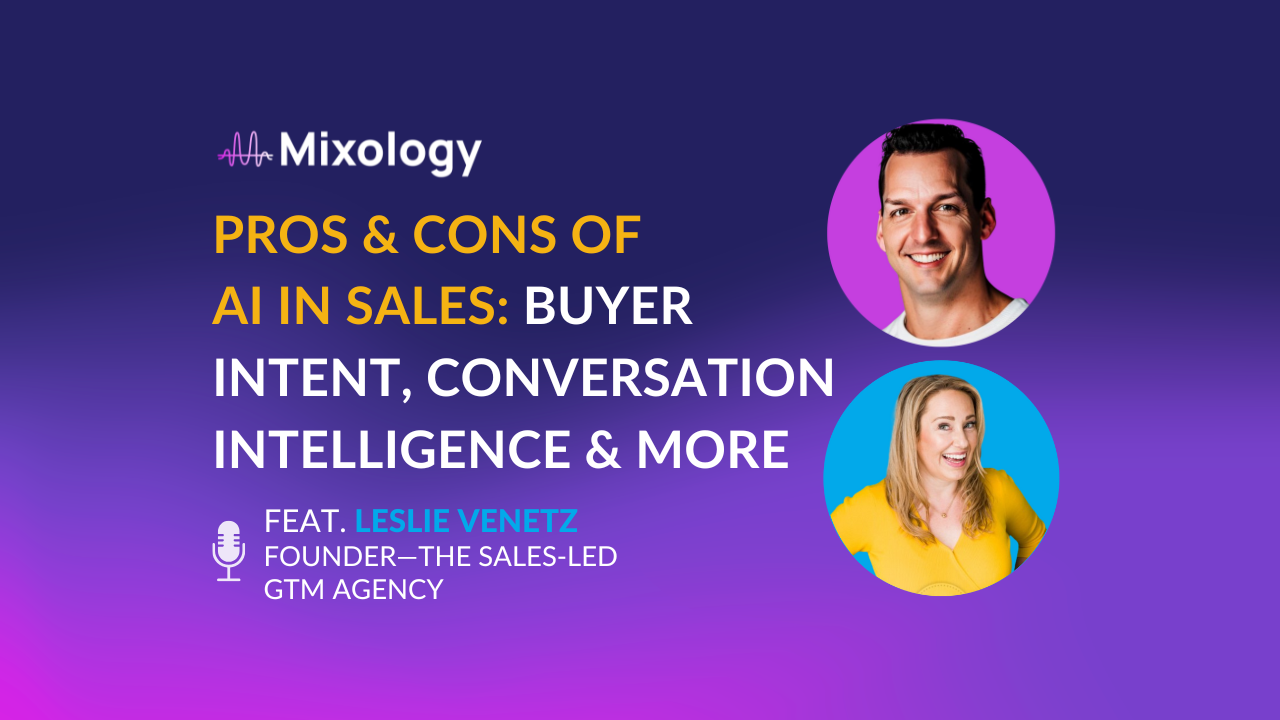With artificial intelligence (AI) weaving its way into nearly every aspect of the sales funnel, sales leaders are navigating uncharted waters.
During a recent conversation between Mixmax’s VP of Revenue, Heath Barnett, and Leslie Venetz, Founder of The Sales-Led GTM Agency, they explored how AI can reshape modern sales strategies—if used thoughtfully.
Here are the highlights, actionable insights, and key takeaways from their discussion on how to use AI in sales the right way to help you embrace a buyer-centric, AI-supported approach.
The evolution of sales: A buyer-centric perspective
One of the recurring themes in the conversation was the shift to buyer-centric sales.
Leslie’s journey into sales began—like many others—unexpectedly. “I got a sales job and was like, ‘I’m quite good at this, and there is a lot of money to be made, and here I am, almost 20 years later.’” But it wasn’t until she started experimenting with different approaches that she discovered something game-changing: empathy and curiosity.
“What made me really good, better than other people at sales was a desire to help people and natural curiosity. And those were not skills that I thought were quote-unquote sales skills,” Leslie explained.
This buyer-first mentality forms the foundation of modern sales strategies—and it’s one that AI can amplify when applied correctly.
Where AI kicks butt in sales
AI has the power to enhance sales teams’ efficiency, but only if it’s applied in ways that serve the buyer rather than creating friction. Here’s where AI can play a transformative role:
1. Reclaiming time for what matters
Salespeople spend far too much time on non-selling activities. Leslie highlighted how AI can alleviate this: “We constantly complain about how much time we spend on non-sales activities. AI helps reclaim that time so we can use it to be more thoughtful and strategic in our approach.”
Examples include:
- Automating meeting scheduling.
- Drafting initial email templates.
- Collating buyer signals from multiple sources
|
P.S. Mixmax’s AI Compose feature helps you draft emails to save time. But we encourage users to always tweak the text to add their human touch before sending. |
2. Leveraging buyer signals to personalize outreach
Signal stacking was a major focus of the discussion. Heath explained how Mixmax combines multiple signals—like website activity, pricing page visits, and content downloads—to create a more complete picture of buyer intent. But as Leslie warned, misinterpreting signals can harm your outreach.
Pro tip: Don’t treat early signals like a green light to push for a sale. Instead, use them to tailor your message. For example:
- Early signals (e.g., downloading a whitepaper): Focus on education and value.
- Mid-stage signals (e.g., multiple visits to your website): Position your product as a potential solution.
- Late-stage signals (e.g., revisiting pricing pages): Engage directly with a personalized message.
3. Enhancing active listening with conversational intelligence
Leslie shared her excitement about AI tools that enhance active listening during calls. “Active listening is actually the most important and most foundational skill for any seller. So when we think about applications of AI, being able to use conversational intelligence bots to free up our mental bandwidth [during meetings] is huge.”
With tools like conversational intelligence bots, reps can:
- Automatically capture call summaries and next steps.
- Track buyer reactions and tone.
- Generate follow-up emails instantly after the call.
|
P.S. Mixmax’s new AI Meeting Assistant takes the hassle out of notetaking and follow-ups—so you can spend less time frantically jotting down every single important thing a prospect says during a call and more time paying attention 😏. |
The limits of AI in sales
While AI is powerful, it’s not a silver bullet. Both Heath and Leslie emphasized that AI can’t replace the human connection buyers crave.
“Even if AI could write the perfect email,” Leslie said, “buyers don’t respond to bots the same way they respond to humans. Mirror neurons don’t fire when we interact with AI. That’s why human connection is irreplaceable.”
So where should automation stop? According to Leslie, automation should eliminate friction, not create it. AI should support tasks like data collection, first drafts, and administrative work—but leave relationship-building to humans.
|
💡Actionable tip: Always ask, “Am I doing this because it serves me? Or am I doing this because it serves the buyer?” If a task only benefits you, it’s time to rethink your approach. |
How sales leaders can enable their teams with AI
For sales leaders, enabling teams with AI requires more than just tools—it demands coaching and thoughtful implementation. Here’s what Leslie suggests:
Understand the difference between training and coaching
“Training is one-to-many,” Leslie explained. “Coaching is one-to-one, and it requires digging into the minutiae of the sales process.”
Great sales leaders don’t just teach reps the tools; they:
- Analyze conversion rates to identify bottlenecks.
- Role-play scenarios to address mindset barriers.
Use AI to streamline repetitive tasks
From automating CRM updates to generating call transcripts, AI can make life easier for reps. But as Leslie pointed out, it’s up to sales leaders to ensure these tools are used in ways that align with buyer-centric principles.
Looking ahead: The future of AI in sales
When asked about the future of how to use AI in sales, Leslie offered a measured perspective: “AI will continue to support reps, but it won’t replace them. The dreams people have for AI—that it’ll replace human thought—are unrealistic. AI is a tool, not a replacement.”
For sales teams, the real power of AI lies in its ability to:
- Enable smarter prospecting.
- Improve deal insights.
- Help reps maintain momentum through the buyer’s journey.
But Leslie also issued a warning: “The systems we’re feeding into AI right now are deeply broken. We’re teaching AI based on processes that don’t work. If we want better outputs, we need better inputs.”
Key takeaways about how to use AI in sales
AI is changing sales, but using it effectively requires a buyer-centric mindset. Here are the biggest takeaways from the conversation with Leslie Venetz:
- AI can save time by automating tasks like scheduling, notetaking, and drafting emails, freeing up reps for more meaningful conversations.
- Personalization is key—using AI-generated buyer signals strategically can make outreach more relevant and engaging.
- Active listening matters—AI tools like conversational intelligence can help reps focus on buyers rather than scrambling to take notes.
- Automation should reduce friction, not add to it—AI should assist, not replace, human interactions.
- Sales leaders must balance training and coaching to enable their teams to effectively integrate AI into their workflows.
As Leslie put it, “The bar for sales messaging is in hell. The good news? It’s not hard to step over it if you listen to your buyers and focus on solving their problems.”





